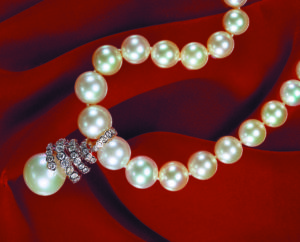A Meditation On Cultured Pearls, Part One:

By Richard W. Wise, G.G. ©2017
Part I
I began my career as a faceted stone man. It took me a long time to warm up to pearls. A fine diamond will blast you with brilliance and a ruby will step right up and sock you in the eye.  Not so the pearl! Pearls seemed so quiet, subtle and refined. Faceted gems trumpet their charms in a burst of visual pyrotechnics. Pearls, it seemed to me, lacked that old flash and dazzle. They were white, they were round, they were a bit of a bore!
Not so the pearl! Pearls seemed so quiet, subtle and refined. Faceted gems trumpet their charms in a burst of visual pyrotechnics. Pearls, it seemed to me, lacked that old flash and dazzle. They were white, they were round, they were a bit of a bore!
My dismissal of the pearl was due to my lack of attention to the subtleties of the gem. John Singer Sergeant, that famous painter of wealthy Belle Époque beauties, required seven separate colors to create a realistic rendering of a single round white pearl. No, the pearl is not simple but to appreciate its beauty requires close attention and serious effort.
The ancients understood pearls, perhaps better than we do. The Greeks associated the pearl with Aphrodite, goddess of love and with the cool reflected light of the moon. More bards and poets have composed verses extolling the beauty and virtues of the pearl than any other gemstone. For the ancients the pearl personified and was a proof of virtue. Cleopatra is said to have dissolved a fabulous pearl in wine and drunk it to prove her constancy to her lover Mark Antony. Of course, she later left him high and dry in Greece, as her ship fled from the scene of their navy’s defeat at the hands of the Roman fleet. But then a woman is entitled to change her mind.
In modern times we like to use scientific rather than poetic language when we talk about gems. Thus we use the term surface to describe what in former times was known as the skin of the pearl. The latter term is more evocative and for that reason more accurate. Like the skin of a beautiful woman, a pearl can be of many colors, dark or light, smooth or blemished, translucent, luminous and alive or opaque, chalky and lifeless.
Like the skin of a beautiful woman, a pearl can be of many colors, dark or light, smooth or blemished, translucent, luminous and alive or opaque, chalky and lifeless.
Pearls today come in many colors. Salt-water akoya pearls may be gray, yellow or white. Southsea pearls may be white, cream, golden or steel gray to black. Chinese freshwater pearls come in plum, bronze, peach and champagne.
The pearls body color by itself is not important in defining the beauty of the gem. It is the combination of body color, luster and translucency that make a fine pearl. The nacre or pearl essence that the animal secretes is a translucent calcium carbonate composed of tiny overlapping crystals of aragonite held together by concholian, a sort of calcium glue. For more information on the connoisseurship of cultured pearls consult: (Secrets Of The Gem Trade 2n Edition) 
